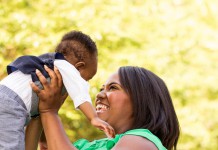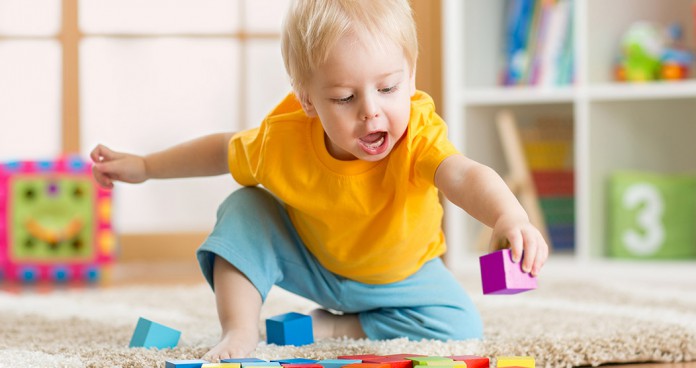Now that your little one has arrived, you’re ready to show her the world. One of the best and fun ways to do that is through play. “Play, whether it’s peek-a-boo, rolling a ball or putting one block on top of another, gives parents a chance to step away from the non-stop care taking role and get to know what their little one enjoys,” says parenting coach Maureen O’Brien, Ph.D. Because each stage of a newborn’s development represents different skill sets and abilities, it helps to understand how different types of play are beneficial.
“One-on-one play forms the foundation for infants’ social skill development”
explains Karen Dudley, a child development specialist. Independent play allows the infant to begin to make sense of the physical and emotional world around her. A good balance of playtime with your baby and allowing her a chance to explore on her own terms helps foster a strong foundation for early learning.

Figuring out when to play with your newborn is just as important as what to play. According to Luiza DeSouza, author of Eat Play Sleep, the best time to play is right after feedings, when babies are most happy and alert. But, as she explains, it’s better to wait a few weeks before getting started. “During the first month, babies tend to eat and fall asleep. It is during the second month that they become more alert. Play time should be encouraged right after feedings.”
Just as important as a full stomach is a newborn who is well-rested or, in what Dudley describes as a “calm alert state.” “This is the time when you see them looking around calmly and happily noticing what is around them,” she says.
“This is the condition in which infants are most able to notice and integrate new information.”
To help you determine what types of toys work best for your baby at different ages, experts offer their suggestions for how to make playtime fun for both of you.

Taking cues from your newborn as to whether they are willing to play is also key. “Babies have different states of alertness and in most alert states, play can be fun,” says O’Brien. “But a tired [or] hungry baby will fight play activities that they adored when they were more relaxed.” Paying attention to how your baby responds to the tone of your voice and how quickly or slowly you handle each toy will also help you determine how to play.
Once your baby has awoken from her nap, has been fed and is ready to play, you’ll want to make sure you have the right toys on hand, depending on her age. Introducing a new toy or two every month will keep her entertained, without becoming too overwhelming.
“Babies like familiarity because they find it comforting,” says O’Brien. Keeping things simple is the best approach to playtime for the first few months. In fact, your own voice can be an effective, engaging tool for your child as you sing and tell stories (and don’t worry about whether or not you can carry a tune; it’s more about familiarity than anything else). “Songs and rhymes help children learn the cadence and rhythm of the language they will be speaking, and are an early way to help infants remember words and phrases,” offers Dudley. Little ditties like “The Itsy Bitsy Spider” and “Twinkle, Twinkle Little Star” are ideal, as is dancing to your favorite song while holding your little one. When you’re playing together, you can shake a rattle for sound and sight stimulation, and when your newborn is playing alone, try placing black-and-white pictures about 6 inches away from her face.

For nap time or quiet time in a crib or bassinet, try a mobile with rotating toys. “Babies enjoy looking at moving objects, and if the mobile or suspended objects are low enough, they may even start trying to bat them with hands or feet,” she notes, which helps develop hand-eye coordination.
At 4 to 6 Months, babies are learning how to grasp and hold objects, which builds their fine-motor skills. But be wary of smaller objects that may easily move from hand to mouth. O’Brien advises:
“Stick with lightweight toys. These include rattles, wooden rings and soft toys with tags.”
Infants learn from the objects that they put in their mouths and often find comfort in mouthing objects. Small parts can cause a potential choking hazard, so stay away from anything that isn’t designed for teething.
Cause and effect is a newly acquired skill at this stage of development, so encourage your baby to make some noise. Holding and banging objects together, such as pots and pans, a drum, xylophone or toy hammer, will stimulate the senses. “Mom can sit her baby on her lap and encourage him by saying, ‘Bang, bang, bang,’ which helps promote language development,” notes DeSouza.
What a difference a year makes! Your baby is now mobile, crawling around and exploring (and in some cases, already walking). Any toys or games that encourage him to move around are a great way to develop gross motor skills. Dudley suggests gentle chase games in which you follow as you baby crawls or walks away.

When he’s not on the go, your baby may be more inclined to check out toys that can be manipulated, such as containers that fill and spill, dump trucks, pop-up toys and stacking rings.No matter how old your baby is, experts laud the benefits of incorporating some outdoor playtime, whenever the weather permits. It’s a great mood booster for a fussy newborn.
“The change in air quality and sounds is often soothing,” says Dudley, who likens moving leaves to a natural mobile. Older babies can also benefit from outdoor tummy time, a position that helps promotes crawling.
And don’t let a little rain spoil your outdoor playtime. “Infants even enjoy being out in the rain under an umbrella and watching, hearing and feeling the world in this new condition,” says Dudley.



















